To understand this part of the tale I need to recap and recall some events leading up to the visit to Lagina in 2005.
Many, many, years ago I discovered that it wasn’t the five-pointed star which would serve as my personal amulet but the LABRYS. I came across it during a visit to Knossos, Crete in the early 1980’s. I was fascinated by, what was coined as Minoan Culture* and the Snake Goddess. And of course the Labrys and Labyrinth which was found there.
In Greek mythology, King Minos dwelt in a palace at Knossos. He had Daedalus construct a labyrinth (by some connected with the double-bladed axe, or labrys) in which to retain his son, the Minotaur. Daedalus also built a dancing floor for Queen Ariadne.
I was so fascinated that I bought a small silver labrys. That my path subsequently felt sometimes like a labyrinth with dead ends, it nevertheless acted as a trigger. At the time there were differing viewpoints about the function of Knossos. Was it a palace? Or a temple complex where initiations took place? Who was the Snake Goddess?
Walking through the site and the visit to the underground chambers seemed to recall vague ancient memories. Memories of holding the labrys as a pennant. Of serving the Queen as a priestess or maiden.
BEES & HONEY
There is much evidence of water management and instances of bath-tubs at Knossos. I remember however that there was something odd about a particular tub and later found out that these tubs hadn’t only been used for washing or ritual baths but embalming. It wasn’t water which was used but honey. I have since found this myth or ‘Riddle of Glaucos’ which not only notes Glaucos as son of King Minos but also the role of snakes. 🙂
“The ancient belief that anyone who drowned in honey would revive, is best illustrated in the legend of Glaucos.
Glaucos, the son of the Cretan King Minos, while playing with a mouse (the symbol of death) fell into a jar of honey and drowned. Minos searched for him in vain. At last he appealed to the oracle of Apollo and only under its guidance did he find the body of his son. Apollo announced to Minos: “A monstrosity has been born in your land and the person who will be able to discover its meaning shall find and restore your son.” The whole country looked for the monstrosity, which was very soon found. It proved to be a calf which changed its colour thrice daily; first it was white, then it became red and finally black.
Minos summoned all his augurs to find out what this signified. The seer Polydos was the one who could construe its meaning. He thought the calf represented a mulberry tree, the fruit of which is first white, afterwards red and when ripe, black. Minos ordered Polydos to find his son. At first he hesitated but after he was compelled, he commenced his search for the lost son of the King.
Polydos, during his long wanderings, passed a honey-bin, on top of which an owl was perched, driving away some bees. He considered this an omen, entered the bin and found Glaucos, drowned in a vessel of honey.
Polydos notified the King of the recovery of Glaucos’ body. The seer was locked in an Old Cretan vault with the corpse and ordered to resuscitate it. A snake soon crawled toward the body of Glaucos, but Polydos killed the snake. Another snake, bearing an herb, laid this over the dead snake, which at once revived. Polydos then placed the same herb over the body of Glaucos, who immediately came to life. Polydos received royal rewards for his deeds and was discharged, laden with treasures.
The circumstance that the bees which tried to enter the honey-bin were driven away by the owl, was symbolical of the fact that the bees, representing the soul of the deceased, were using their best efforts to regain their former habitation and were prevented only by the sinister influence of the owl.” (from “Honey used in death rituals” http://www.honey-health.com/honey-used-in-death-rituals/)
There are also reliefs where Minoans are carrying amphora of honey as gifts to the Egyptians. Did they also teach the Egyptians the art of embalming? One thing we do know is that the medicinal and nutritional use of honey and the importance of bees pre-dates Knossos.
Bees are reported as being the first domesticated animal probably going back some 20.000 years.
Andrew Gough writes:
“In fact, Bees were venerated in pre-history and revered in ancient cultures far and wide, especially Egypt. So how did the veneration of the Bee evolve from there? In ‘The Myth of the Goddess: Evolution of an Image, Anne Baring and Jules Cashford reflect on the importance of the Bee in one region in particular – the Mediterranean; Bees have an ancient reputation as the bringer of order, and their hives served as models for organizing temple in many Mediterranean cultures.”
It may be worth noting at this point that the Turkish word for beehive is ‘arı kovanı’ and hive: ‘kovan’. This sounds like a very familiar word… coven. Is this a coincidence? As many witches can attest many words and concepts used in craft circles relate to Bee culture. We even talk of ‘hiving off’ when a Priest or Priestess leave the mother coven to begin their own hive/kovan.
Apiculture is still very popular in the province of Caria as I saw when travelling from Bodrum to Lagina and later Labranda.
In the same area is the Temple of Apollo (Didyma) which I have talked about in an earlier article in the ‘Tales of Anatolia’ series. It was Aristaeus, son of Apollo and Cyrene, who was also known as the ‘Honey-lord’ and thought to be the inventor of honey making.
It was in Malia, Knossos too where this amazing brooch was found:
The three drops of honey so prominently visible! But it was this image of a bee goddess which made me realise that the Labrys was also closely connected to Bees:
Standing in the classic ‘Goddess position’ this seems to me to be the embodiment of the mystery not only of bees but also the Labrys.
And this seal ring from Knossos:
Here the priestesses also echo the Snake Goddess mentioned earlier. As we know snakes are symbolic of the genius loci and was the ‘protective spirit of place’. They and the Bees are also connected to Chthonic processes:
“The chthonic process is an occult ‘awakening’ that includes the very lowest instinctual elements of the human psyche leading to the very highest elements. It is the base, primordial material that the psyche needs in order to evolve and grow. Chthonic is the soil, the fertilizer, and the dark, primitive unconscious material that can turn the beast into a god.” (Chthonic: From Beast to Godhead by Vadge Moore)
That mead, honey-wine, was the Ambrosia of the Gods and the drink of inspiration not only in Asia Minor but also in the Northern Europe should also not come as a surprise.
LABRYS AND LABRANDA
When I first went to Bodrum in 2005 I not only visited Lagina but also Ephesus. Whilst talking to one of the guides there he suddenly said “You are one of us…” I wondered what he meant. He then pointed to the silver Labrys that I was wearing. I thought it was a bit odd because I had always associated the Labrys with Crete. I later found out that Carian mercenaries had gone to Crete and probably took the Labrys too… perhaps as an amulet but most probably as a reminder of home. It turns out that the Labrys is still the the symbol of Caria… and why the guide remarked that I was “one of them..” Little did he know how right he was 🙂
After the visit to Lagina with the delegation (Hekatesia 2005) and the ritual dedicated to Hekate a number of us visited LABRANDA the following day. We had already noted the connection between Hekate & Zeus and the proliferation of double-axes at the sanctuary at Lagina. So I was more than curious to find out more about the Temple of Zeus, also known as Labranda or Labraundos.
“Labraunda (alternatively Labranda Ancient Greek: Λάβρανδα) is an ancient archaeological site five kilometres west of Ortaköy, Muğla Province, Turkey, in the mountains near the coast of Caria. In ancient times, it was held sacred by Carians and Mysians alike. The site amid its sacred plane trees [1] was enriched in the Hellenistic style by the Hecatomnid dynasty of Mausolus, satrap (and virtual king) of Persian Caria (c. 377-352 BCE), and also later by his successor and brother Idrieus; Labranda was the dynasty’s ancestral sacred shrine. The prosperity of a rapidly Hellenised Caria occurred during the 4th century BCE.[2] Remains of Hellenistic houses and streets can still be traced, and there are numerous inscriptions. The cult icon here was a local Zeus Labraundos (Ζεὺς Λάβρανδος), a standing Zeus with the tall lotus-tipped scepter upright in his left hand and the double-headed axe, the labrys, over his right shoulder. The cult statue was the gift of the founder of the dynasty, Hecatomnus himself, recorded in a surviving inscription.[3]
In the 3rd century BCE, with the fall of the Hecatomnids, Labraunda passed into the control of Mylasa. The site was later occupied without discontinuity until the mid Byzantine period.”
Although the road from Lagina is very badly in need of repair as I found out on my return trip in 2012 the site itself is in a most beautiful area.
It is thought that there was a golden Labrys.
“The axe cast of gold had been kept in the Lydian capital Sardes for centuries. The Lydian king Gyges awarded it to the Carians, to commemorate Carian support in a battle. This is the mythic anecdote: the social and political reality may have been more complicated, for such ritual objects are never lightly passed from hand to hand or moved from their fixed abode. Upon receiving this precious, purely ritual axe, the Carians kept it in the Temple of Zeus at Labraunda.”
Perhaps it looked like this:
Zeus as Thunder God
When I looked at the mythology of Zeus and the Labrys I was literally struck by a ‘lightning bolt’. Not only is the birth of Zeus connected to the Melissae, the Bee priestesses but also as Thunder God one of his major symbols is the Lightning Bolt… Now where have we heard of another Thunder God with a hammer, or axe… Indeed THOR with the Mjolnir.
Today there are thousands of different designs and sometimes people mistake my labrys for Thor’s Hammer.
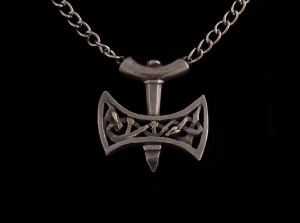
In 2012 I was also reminded of the visit to Sweden in June 2005 when I learnt about ancient funerary rites. First the body was burnt, then cold water was thrown on to smatter the bones. The remaining bones were then placed in an urn and buried. I also learnt that spirits were called by hitting a rock on to another stone which “rang”. Fire, water, earth and air/spirit.
When I was in Bodrum in 2005 I was shown a photograph of a stone with two ears clearly carved and in between .. a Labrys. I was suddenly struck by the idea that the labrys wasn’t an axe but represented the two lungs with the windpipe .. in other words allowing us not only to hear the messages of the gods but also to be as thunder gods.
(See the full story Tales of Anatolia: From Hekatesia to Aphrodisias, Part 1- July 2012, by Morgana).
Coincidentally: “The Royal Swedish Institute at Athens has been in charge of archaeology at Labraunda, notably in a series of campaigns in 1948-53, initiated by Axel W. Persson and taken up, after the latter’s sudden death, by Gösta Säflund, has published its findings in a long series, grouped as four volumes, from 1955 onwards.”
There is a wonderful website also dedicated to the findings:
http://www.labraunda.org/Labraunda.org/How_and_Why_eng.html
The other striking thing about Labranda was the spring. At Lagina we had seen a sacred spring and once again we found one here. In fact it was the mini bus driver who literally dragged me to the site saying “Here is the sacred well, with the sacred bees, who drink the sacred water to make the sacred honey” 🙂
And look at this ..are these bee priestesses? The motif is very bee-like and reminiscent of the dancing bee priestesses at Knossos.
In 2005 I didn’t know what I know now. Indeed little did I know what Hekate was calling me for. However I know now that her call has made me aware of the plight of the Bees. She has also made me aware of our inter-connectedness between all living beings including the Earth as a sentient being. I have become aware of the connection with Hekate and Zeus, the Labrys as reminder of the messages of the Gods but also the in-breathing, the In-spiritus and In-spiration, is a constant reminder of our responsibility as priests and priestesses to this our home, planet Earth.
We as guardians of the land!
And as final tribute we can read in The Theogony of Hesiod:
“Again, Phoebe came to the desired embrace of Coeus.…. Also she bare Asteria of happy name, whom Perses once led to his great house to be called his dear wife. And she conceived and bare Hecate whom Zeus the son of Cronos honoured above all. He gave her splendid gifts, to have a share of the earth and the unfruitful sea.
She received honour also in starry heaven, and is honoured exceedingly by the deathless gods. For to this day, whenever any one of men on earth offers rich sacrifices and prays for favour according to custom, he calls upon Hecate. Great honour comes full easily to him whose prayers the goddess receives favourably, and she bestows wealth upon him; for the power surely is with her. For as many as were born of Earth and Ocean amongst all these she has her due portion.
The son of Cronos did her no wrong nor took anything away of all that was her portion among the former Titan gods: but she holds, as the division was at the first from the beginning, privilege both in earth, and in heaven, and in sea. Also, because she is an only child, the goddess receives not less honour, but much more still, for Zeus honours her. Whom she will she greatly aids and advances: she sits by worshipful kings in judgement, and in the assembly whom she will is distinguished among the people.
And when men arm themselves for the battle that destroys men, then the goddess is at hand to give victory and grant glory readily to whom she will. Good is she also when men contend at the games, for there too the goddess is with them and profits them: and he who by might and strength gets the victory wins the rich prize easily with joy, and brings glory to his parents. And she is good to stand by horsemen, whom she will: and to those whose business is in the grey discomfortable sea, and who pray to Hecate and the loud-crashing Earth-Shaker, easily the glorious goddess gives great catch, and easily she takes it away as soon as seen, if so she will.
She is good in the byre with Hermes to increase the stock. The droves of kine and wide herds of goats and flocks of fleecy sheep, if she will, she increases from a few, or makes many to be less. So, then. albeit her mother’s only child (17), she is honoured amongst all the deathless gods. And the son of Cronos made her a nurse of the young who after that day saw with their eyes the light of all-seeing Dawn. So from the beginning she is a nurse of the young, and these are her honours.”
Notes, sources:
CRETE, KNOSSOS:
* The term ‘Minoan‘ was coined by Arthur Evans, a British archaeologist in 1903. He used the name after King Minos who was associated in Greek myth with the labyrinth and which Evans identified with the site of Knossos.
http://en.wikipedia.org/wiki/File:Museu_arqueologic_de_Creta24.jpg
http://www.honey-health.com/honey-used-in-death-rituals/
http://www17.us.archive.org/stream/honeyhealth00beck/honeyhealth00beck_djvu.txt
http://en.wikipedia.org/wiki/Zeus_Labraundos
ARISTAEUS, BEE GODDESSES AND BEES: http://www.britishmuseum.org/research/collection_online/collection_object_details.aspx?objectId=1520694&partId=1&people=125020&peoA=125020-2-23&page=1
http://beewytch.blogspot.nl/2013/09/mythology-aristaeus-greek-god-of.html
http://www.andrewgough.co.uk/bee2_1.html
http://aphroditespriestess.blogspot.nl/2012/07/m-melissae-bees-paganblogproject.html
http://www.society.kosmic-gnosis.org/words/chthonic.html
LABRANDA AND LABRYS
http://en.wikipedia.org/wiki/Zeus_Labraundos#Labraunda_and_labrys
http://www.guide-martine.com/aegean9.asp
http://www.pbase.com/dosseman/labranda
http://www.historywiz.com/galleries/labrys.html
http://www.labraunda.org/Labraunda.org/bibliography_other_eng.html
ZEUS & HEKATE
http://www.sacred-texts.com/cla/hesiod/theogony.htm
http://www.museumkennis.nl/lp.rmo/museumkennis/i000473.html
Tales of Anatolia: Hekatesia 2005
Tales of Anatolia: From Hekatesia to Aphrodisias, Part 1- July 2012
by Morgana
Tales of Anatolia: From Hekatesia to Aphrodisias, Part 2- July 2012
by Morgana

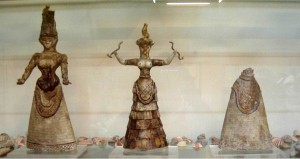
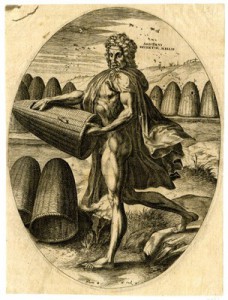
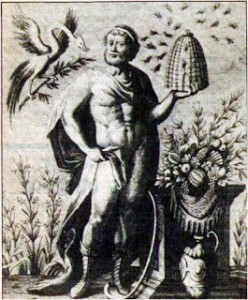

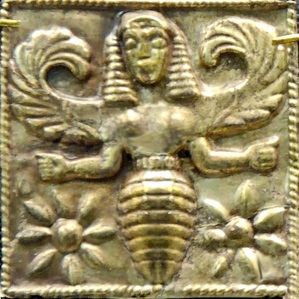
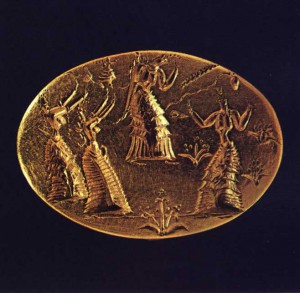
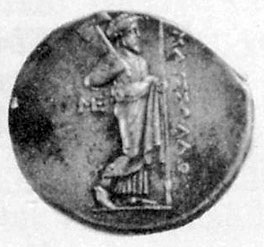
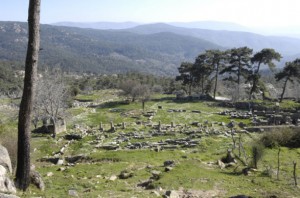
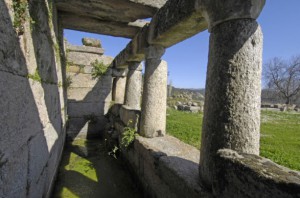
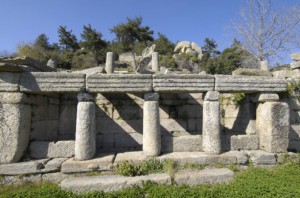
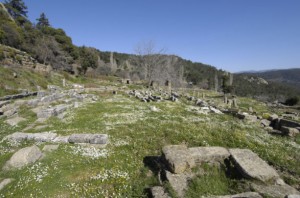
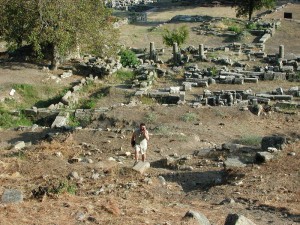
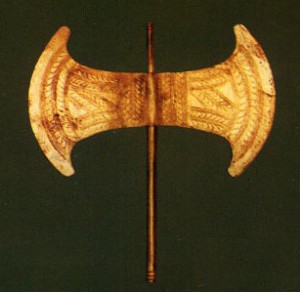
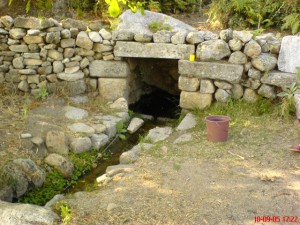
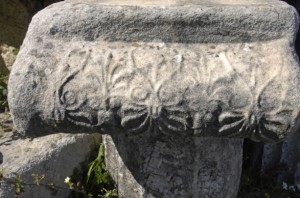
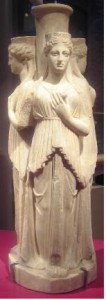
Very interesting. And beautiful pictures too.
I’ll have to make time to read all of this!